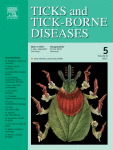Ver ítem
- xmlui.general.dspace_homeCentros Regionales y EEAsCentro Regional Santa FeEEA RafaelaArtículos científicosxmlui.ArtifactBrowser.ItemViewer.trail
- Inicio
- Centros Regionales y EEAs
- Centro Regional Santa Fe
- EEA Rafaela
- Artículos científicos
- Ver ítem
Amblyomma parvum Aragão, 1908 (Acari: Ixodidae): Phylogeography and systematic considerations
Resumen
The geographical distribution of Amblyomma parvum Aragão 1908 in the New World is disjunct, with two main clusters separated from each other by the Amazon basin. The main objectives of this study were to further investigate the systematic relationships within A. parvum, to determine whether or not populations from different geographical areas might represent cryptic species, and to reconstruct the phylogeographical evolutionary history of the species. The
[ver mas...]
The geographical distribution of Amblyomma parvum Aragão 1908 in the New World is disjunct, with two main clusters separated from each other by the Amazon basin. The main objectives of this study were to further investigate the systematic relationships within A. parvum, to determine whether or not populations from different geographical areas might represent cryptic species, and to reconstruct the phylogeographical evolutionary history of the species. The genetic diversity of A. parvum collected throughout its distributional range was analyzed by using 6 molecular markers: 5 mitochondrial [the small and the large ribosomal subunits 12rDNA and 16SrDNA, the cytochrome oxidase I (COI) and II (COII) and the control region or d-loop (DL)], and one nuclear (ITS2, Inter transcribed spacer 2). Phylogenetic trees were inferred by using maximum parsimony and Bayesian analyses. In addition, node dating was attempted for the main lineages identified phylogenetically. Although mitochondrial and nuclear topologies were not totally congruent, they all identified at least two main supported clusters, a Central American lineage, and a Brazilian-Argentinian lineage. Clade support and divergence values strongly suggest that the two lineages correspond to different taxonomic entities. Node dating placed the split between the Central American and the Brazilian-Argentinian lineages at approximately 5.8–4.9 Mya, just after the progressive replacement of the dry areas that occupied the northern part of South America by the Amazon Basin in the early-mid Miocene. This event might be the cause of fragmentation and putative speciation within the ancestral relatively xerophilic A. parvum population.
[Cerrar]

Autor
Lado, Paula;
Nava, Santiago;
Labruna, Marcelo B.;
Szabó, Matías P.J.;
Durden, Lance A.;
Bermudez, Sergio;
Montagna, Matteo;
Sánchez Quirós, Ana C.;
Beati, Lorenza;
Fuente
Ticks and Tick-borne Diseases 7 (5) : 817-827 (July 2016)
Fecha
2016-07
ISSN
1877-959X
1877-9603
1877-9603
Formato
pdf
Tipo de documento
artículo
Palabras Claves
Derechos de acceso
Restringido
 Excepto donde se diga explicitamente, este item se publica bajo la siguiente descripción: Creative Commons Attribution-NonCommercial-ShareAlike 2.5 Unported (CC BY-NC-SA 2.5)
Excepto donde se diga explicitamente, este item se publica bajo la siguiente descripción: Creative Commons Attribution-NonCommercial-ShareAlike 2.5 Unported (CC BY-NC-SA 2.5)

